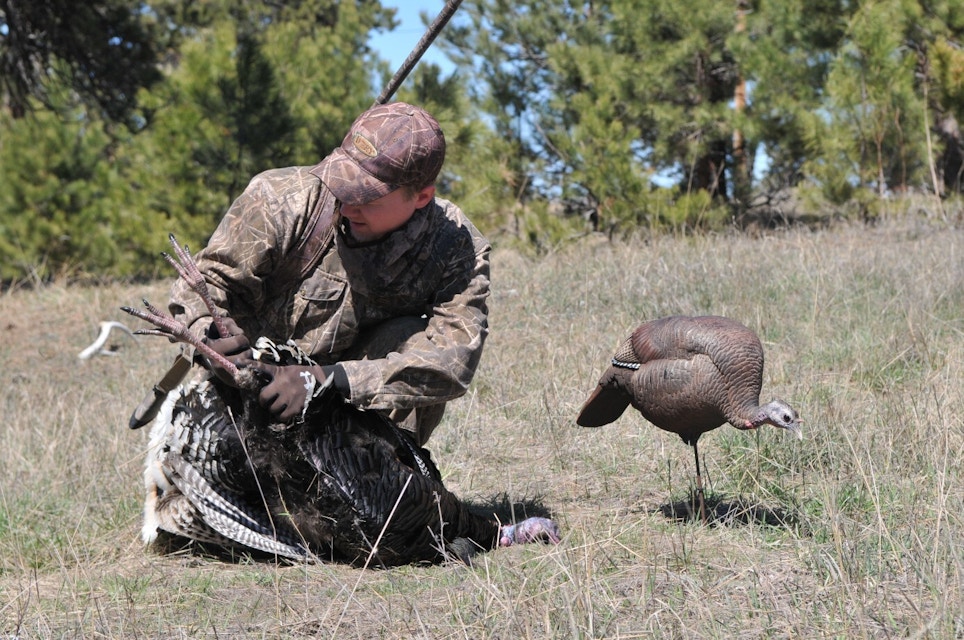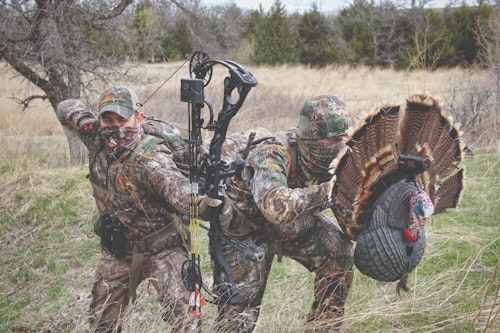Collapsible, inflatable, motion, laydown, strutter, half strutter, upright, feeder… the list goes on and on. For someone who isn’t a grand-slamming turkey-hunting connoisseur, understanding what makes turkey decoy A better than decoy B and different than decoy C is a challenge that takes more than just reading the word-smithed description on the packing. While first-hand experience is best, for those that haven’t reached expert-level quite yet, this guide will teach you to talk turkey without even knowing the language.
Why Decoys Matter
First, the basics for those of you who aren’t turkey hunters.
In the spring, the reason tom turkeys are vulnerable is simple: They are love-crazed and looking for a receptive hen. The mating ritual for turkeys starts with a tom gobbling on the roost, hens yelping in response and eventually flying to the base of his tree, and then the tom flying down to strut his stuff in courtship. This is what happens nearly every morning of the breeding season, especially when we are talking about the king of the roost.
What makes turkey hunting, and thus decoying, so unique is that hunters are attempting a role reversal, bringing the tom to the hen. While it is possible to get up at dark-thirty and slip in under his roost to be the hen at the base of his tree, in most cases when decoys are involved, hunters are placing decoys as a trap to attract the tom with their call and then lure him into range with a visible fake. In simple terms, despite reversing nature, it works, and decoys often play a key role.
Materials and Whatnot
Turkey decoys are manufactured in materials including everything from hard plastics to faux-feathers, all aimed at fooling turkeys (and maybe buyers) into strutting their stuff into range. The truth is, the material, for the most part, isn’t what makes decoy A more attractive to an excited tom than the material of decoy B. That isn’t to say in very specific situations that a decoy covered in realistic imitation feathers won’t outperform a plastic decoy, but 95% of the time, the material doesn’t matter to an unsuspecting turkey —after all, their brain is the size of a walnut.
Where turkey decoy material does make a difference is during setup and transport. Hard plastic decoys are very loud and cumbersome to carry. Even when they are placed in a soft carry bag, when they bump into sticks or twigs or bang the decoy stake, it is like someone is beating a snare drum in the woods. In some cases, this might not matter, but if a hunter is trying to slip in under a roost or make a stealthy move through the woods, these sounds will put a turkey on high alert. On the other hand, soft plastic decoys are quieter to transport and setup, allowing the hunter to operate in stealth mode.
While soft decoys have advantages in the noise and transport department, they have their own downfalls. In most cases, soft plastic or foam decoys are designed to collapse as small as possible, allowing the hunter to carry potentially more decoys with less bulk. To achieve this, the decoys are made to be inflatable or flexible, requiring the hunter to inflate or shape them in the field. While this option is nice for those traveling long distances to hunt, it isn’t without shortcomings. Inflatable decoys must be blown up to find their shape. In some cases, that isn’t an issue, but often, it’s a problem. I don’t know about you, but after running a few hundred yards to cut off a turkey, the last thing I have is enough wind to inflate a decoy! In the case of non-inflatable soft plastic or foam decoys, getting them into shape, especially after being folded for a few days or weeks, can be a challenging task. While they can be generally coaxed into the form of a turkey, it takes some time and energy, and maybe a few curse words, to make it happen.
Turkey Shapes
Likely more important than the material, the style/position of the decoy is what can make or break a turkey hunt. Turkey decoy setups can broken down into three different categories: Aggressive/Breeding, Passive, and Content. While that sounds like a straightforward approach, selecting the right decoy for each scenario is key.
Aggressive/Breeding: In situations where a hunter has been watching a boss strutting tom court his hens, placing out a full strut decoy in his strut zone is a great way to create visual draw while inciting an aggressive reaction. On some turkeys, this is about as effective as it gets, but on turkeys that have already had their butts kicked by another tom or aren’t the dominant bird, it can shut them down or keep them just outside of range as they skirt around the decoy. So, don’t be afraid to warn a buyer that a strutting decoy is not a one-size-fits-all solution, despite it being an effective way to attract a tom even if he is already with his group of hens. Simply put, a strutter is not something hunters should use every time they hunt.
Instead, a potentially more universally effective approach to attract both the dominant and subdominant toms is one of my personal favorite tactics. Instead of a full-strut tom, hunters should place a lay-down hen underneath a half-strut jake decoy. Many manufacturers make this combination, including Avian-X and Dave Smith decoys, but it can also be achieved using any jake decoy and an upright hen that you simply place on the ground instead of on a stake. Using this sub-dominant jake decoy over top of a hen turkey in a breeding position will get the attention of most adult gobblers, as they think they are missing out on the, um, action.
Passive: Passive decoying involves a much more subtle approach and is used to create visual attraction and put a face to the sound of a calling hen. Decoys in this realm are not necessarily used to exploit the hot-headedness of a love-struck tom, but instead used to simply provide something visual to draw in a turkey. This works especially well in the woods or along a field when blind calling or after getting a response or cutting the distance. An upright hen works best in this situation, as they are more visible, even in tall grass, and they replicate what a searching hen looks like when she is calling to her beaux.
Content: When a customer is hunting fall turkeys or spring turkeys that have been pressured or are near the end of the breeding cycle, deploying a mixed decoy spread is a great way to create a content feel. Using this approach to decoying, hunters should deploy multiple decoys in mixed positions, and this should include jakes and hens. Virtually every decoy, except a full-strut decoy, can be used in this situation, and the number of decoys to use is only limited by what a hunter can carry. This also works well for evening hunts, even during the peak breeding cycle, and especially near the suspected roost. Turkeys find safety in numbers, and by creating an imitation flock, hunters are exploiting their natural desire to be in a flock.
Situational Decoy Basics
Run-and-Gun: If you have been around turkey hunting, you have certainly heard the term “run-and-gun” as a tactic. The definition of run-and-gun is simple. After fly-down, hunters blind call in hopes of eliciting a response gobble to help locate a tom. Once a tom sounds off, hunters attempt to get closer, often by running to cut him off or get to a location where they expect he may travel through or to. This style of hunting is effective, but hunters need to be forewarned that things can happen quickly. In this scenario, a single upright hen is the best decoy for hunters that employ this tactic. They are fast to set up and easy to deploy, and they’re a great visual aid to distract the tom’s attention away from the hunter. Having used this tactic many times, I’ve found that deploying a decoy is especially important on field edges and in open woods where a turkey could hang up if they don’t see the hen that is calling to them.
Ambush: Despite the fact that many hunters claim they don’t use this tactic, they either have or they do. Ambush hunting is setting up where the turkeys go to. This location can be a spot right off the roost, somewhere they feed, or simply a location they pass through. Depending on which location it is, all decoys can be used here. For instance, in an off-roost strut zone, the jake with laydown hen is effective. In travel or feeding areas, one active and one feeder hen is a good choice. The real question is, how many decoys do hunters want to own? If the answer is as many as possible, they can keep a flock in their trunk. If the answer is “I want to own one or two,” an upright hen and jake will be suitable and efficient for most scenarios.
Wait-em-Out: This tactic is often used by hunters who simply want to sit in an area with turkeys, call regularly, and see what happens. This tactic is effective and is a situation where decoys must be used. In many cases, turkeys will come in silently or after only gobbling a few times. If the hunter has been there all morning and regularly calling, there is a good chance that a tom has heard the calls and may come check things out after he is done breeding his hens for the morning. Turkeys have an incredible ability to pinpoint the exact location where the call originates from, so never be surprised when they show up and are looking right at you, especially if there is no decoy out front.
In the end, selling turkey decoys is a matter of reading the customer and understanding want they want and need. Armed with some information on situational tactics and what makes decoys X different then Y, sellers can help seal the deal by being a turkey decoy expert.








